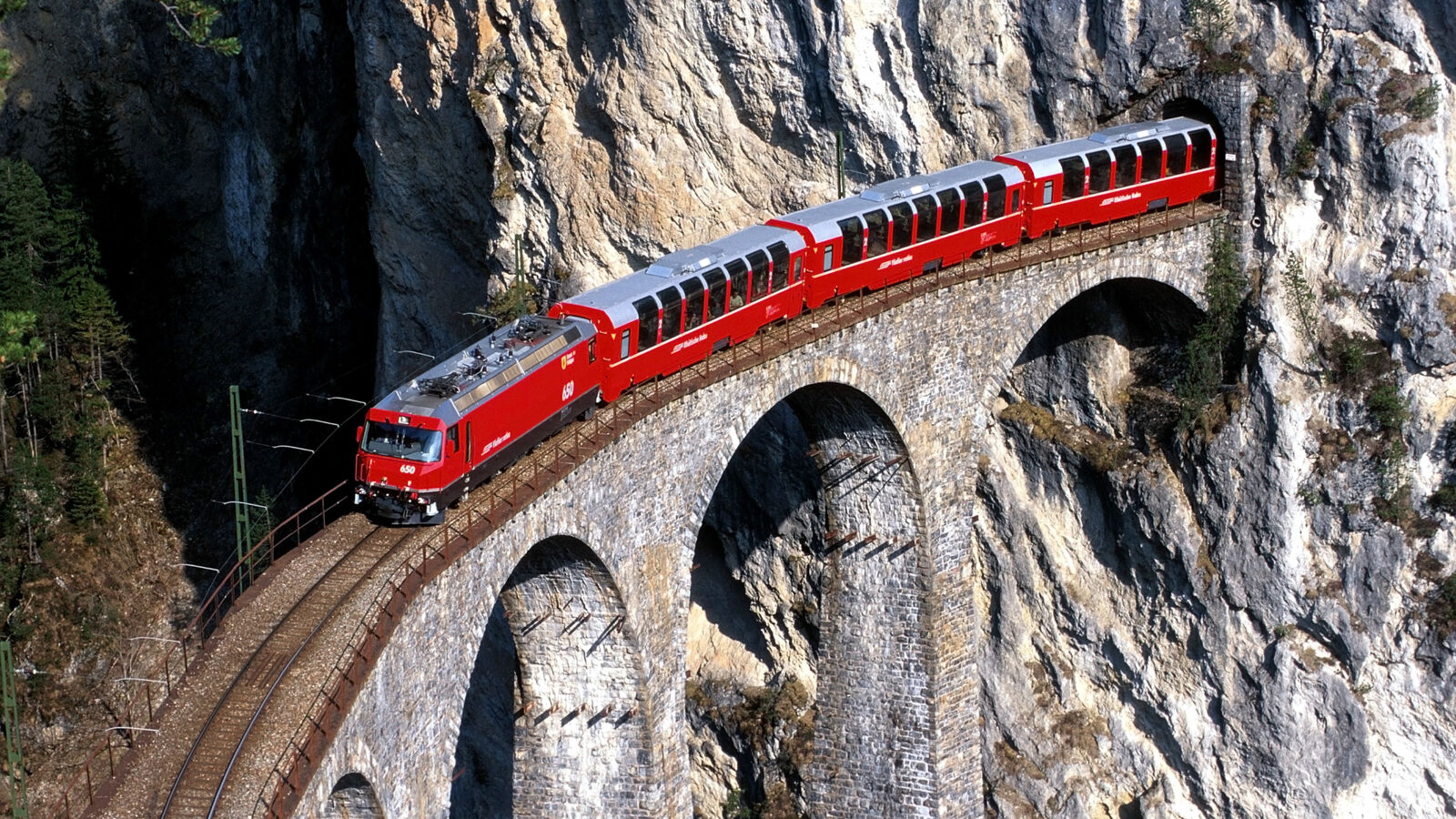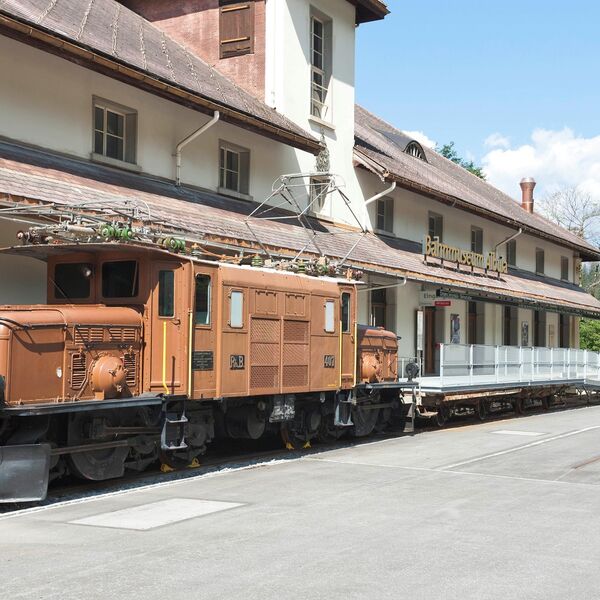Die Kunst des Reisens mit Bahn, Bus und Schiff zu den UNESCO-Welterbestätten
Die Schweiz mag ein kleines Land sein, aber hier gibt es unzählige Orte, darunter 13 UNESCO-Welterbestätten, die man ganz einfach mit dem öffentlichen Verkehr erreichen kann.
Eines sollten Reisende über die Schweiz wissen: Der öffentliche Verkehr rollt in einer Liga für sich. Bahn, Bus und Schiff funktionieren wie ein Schweizer Uhrwerk und mit dem öffentlichen Verkehr lassen sich entlegene Dörfer genauso einfach erreichen wie Berggipfel. Dies macht ein Mietauto in den meisten Fällen überflüssig. Und was gibt es Schöneres, als den Blick aus riesigen Fenstern an Bord eines Panoramazugs schweifen zu lassen, während eindrückliche Landschaften an einem vorbeiziehen – etwa während einer Fahrt entlang der Grand Train Tour of Switzerland? Sie vereint die Strecken der Panoramazüge zu einer einzigartigen Route. Eine davon zählt sogar zum UNESCO Welterbe. Ein Touring-Erlebnis par excellence. Wo gestartet wird, ist jedem selbst überlassen:
Der Swiss Travel Pass ist der Schlüssel zum öffentlichen Verkehrsnetz der Schweiz. Mit einem einzigen Fahrausweis können Reisende 3, 4, 6, 8 oder 15 Tage lang die ganze Schweiz mit Bahn, Bus und Schiff erkunden. Übrigens: Mit dem Swiss Travel Pass erhalten Gäste freien Eintritt in mehr als 500 Schweizer Museen und profitieren von bis zu 50% Ermässigung auf spannende Bergausflüge.Die Verwendung eines Swiss Travel Pass setzt einen ständigen Wohnsitz ausserhalb der Schweiz oder des Fürstentums Liechtenstein voraus.
Wir haben drei Welterbestätten für Sie ausgesucht, die Sie mühelos mit den öffentlichen Verkehrsmitteln erreichen:
Rhätische Bahn in der Albula/Bernina Landschaft.
Der Bernina Express ist eine von zahlreichen Schweizer Panoramabahnen. Die Fahrt von Chur nach Tirano bietet so ziemlich alles, was einen unvergesslichen Trip ausmacht: imposante Sehenswürdigkeiten, Tunnel, starke Steigungen und Aussichten auf eindrückliche Berggipfel. Aber die Bedeutung dieser Strecke geht weit über das Panorama hinaus.
Die Konstruktion dieser Route ist ein wahres Meisterwerk und wird von vielen als ein Meilenstein der Bahn-Architektur betrachtet. Den Ingenieuren ist es trotz des schwierigen Terrains gelungen, die Gleise und Tunnel so zu konstruieren, dass sie förmlich mit der Umgebung verschmelzen. Die Albula und Bernina Strecke von Thusis bis Tirano wurde 2008 offiziell als Welterbe anerkannt, jedoch ist die gesamte Strecke spektakulär. Wer mehr über die 62 Kilometer lange Albula-Strecke erfahren möchte, ist im Bahnmuseum von Bergün bestens aufgehoben.
Schweizer Alpen Jungfrau-Aletsch.
Besucherinnen und Besuchern verschlägt es beim Anblick dieses Welterbes regelmässig die Sprache. Hier befindet sich nicht nur das längste zusammenhängende Gletschergebiet der Alpen, auch die drei weltberühmten Berge Eiger, Mönch und Jungfrau sind hier zu finden. Aber wieso aus der Ferne betrachten, wenn man diese Wahrzeichen hautnah erleben kann? Eine Bergausrüstung benötigt man nicht, denn auf dem Jungfraujoch befindet sich die mit 3‘454 Metern über Meer höchstgelegene Bahnstation Europas. Dies erklärt, weshalb das Jungfraujoch auch als „Top of Europe“ bekannt ist. Seit 2020 kommt man dank dem neu gebauten „Eiger Express“, einer hochmodernen 3S-Bahn, die von Grindelwald Terminal zur Station Eigergletscher führt, noch schneller ans Ziel. Anschliessend geht es von dort mit der Zahnradbahn bis nach ganz oben.
Stiftsbezirk St. Gallen.
Der irische Mönch Gallus legte 612 den Grundstein für die Abtei, die zu einem wichtigen Zentrum der Schreibkunst und Buchmalerei aufstieg. Doch für viele Besucherinnen und Besucher ist die Stiftsbibliothek die Hauptattraktion. Der Rokokosaal zählt zu den schönsten der Schweiz, und die 170‘000 antike Schriften umfassende Büchersammlung versetzt einen immer wieder ins Staunen. Die Sammlung ist einzigartig und beinhaltet, unter anderem, seltene Manuskripte sowie das älteste erhaltene deutschsprachige Buch. Man fühlt sich hier wie in einem Märchen, daher erstaunt es nicht, dass dieser Schauplatz 1983 UNESCO Welterbe wurde. Mit dem Swiss Travel Pass gelangen Gäste ganz einfach dorthin. Per Schnellzug erreicht man St. Gallen von Zürich aus in nur 1 Stunde und 13 Minuten.










